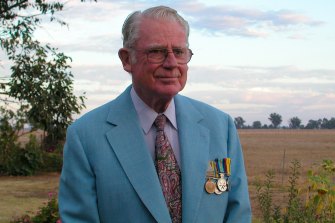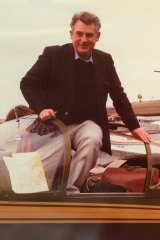Developed pioneering surgical procedures
IAN ALLAN LE GAY FERGUSON, FRACS FRCS June 2, 1927-April 14, 2022
Leading vascular surgeon Ian Ferguson, who has died at 94, was known for lifelong ‘grand obsessions’, which drove him to seek excellence and to live life to the fullest extent.
Ian was born in Longreach in central western Queensland and spent his early years at the Westbourne Wool Scour at Barcaldine. At the age of nine he lost an eye in a farm stockwhip accident. This dashed his dream of being an air force pilot but did not limit any other aspiration. Ian missed some years of school and was educated intermittently at home while working on the family properties.

Ian Ferguson in 2005.
He completed his formal schooling at Geelong Grammar School and went on to study medicine at the University of Melbourne, graduating in 1951. After his residency year, he served a year in Korea. On return to Australia, he was a registrar at The Alfred hospital in the professorial surgical unit. During this time, he developed an excellent oxygenator pump that worked well in the laboratory and in 1957 operated the pump used by Ken Morris in the first successful open-heart surgical operation in Australia.
After qualifying as fellow of the Royal Australian College of Surgeons in 1957, Ian travelled to England where he worked in Guys Hospital London, achieving fellowship of the Royal College of Surgeons and returning to Australia in 1961. He rejoined the thoracic unit of The Alfred and took on the vascular surgery work. The load of arterial surgery progressively increased, and it became evident that a separate unit was needed. The vascular surgery unit at The Alfred, the first in Australia, was formed in 1974 with Ian as head supported by surgeons Sam Rosengarten and Ken Stuchbery.
The unit developed a reputation for pioneering new procedures with much success. At first the main peripheral arterial grafts were femoro-popliteal grafts, but Ian realised that venous grafts could be taken down to the tibial vessels in the lower leg, undertaking successful femoro-tibial bypass surgery. He was one of the first in the world to do this, if not the first, and he certainly was in the English-speaking world. As a result, many legs were saved, immeasurably improving patients’ quality of life. The unit also had success performing carotid surgery to prevent strokes and preventing and repairing ruptured aortic aneurysms. The Ian Ferguson Vascular Laboratory commemorates his pioneering work at the hospital.
In 1966, Ian led a surgical team from The Alfred to Bien Hoa in Vietnam. They were there for three months operating on Vietnamese civilians mainly suffering trauma from guerrilla and anti-guerrilla activities in the war. In between war casualties, the team repaired many cleft palates in children. He hosted prime minister Harold Holt on a tour of the hospital during a visit to the troops in Vietnam.
Ian also had many hobbies he pursued with passion.
He was a keen fly fisherman who loved going camping and trout fishing with his friends in the bush of Victoria and NSW. Some of the best times for his first wife Kath and his young family were the summer holidays to Lake Eucumbene in NSW, where Alfred medicos and their families would enjoy a month of fun, staying in a rambling homestead at the lake’s edge on a large property.
Life at The Alfred included some daring motor racing around the proposed grand prix Albert Park Lake circuit at night with another Alfred colleague and Ian both driving their Bristols. Ian also owned two Bugattis at different times, a Type 57C for more than 30 years, plus two Ferraris. He spent many evenings working on the Bugatti, and weekends at hill climbs and rallies. He was an inaugural member of the Australian Bugatti Register and the Ferrari Owners Association and enjoyed close long-term friendships with other members.
Flying was a lifelong passion. From the late 1960s, Ian became involved in gliding, competing in state and national championships. Later, he obtained a general aviation licence and bought a Chipmunk in which he did aerobatics and used for towing gliders. Subsequently, he became interested in building and flying ultralights, becoming agent for the Robertson B1-RD and later for the CFM Shadow. About this time, Ian and his wife Juliet bought a farm so they could have an airstrip for their various aeroplanes. The property was about 220 hectares so, as Juliet put it, they also had to become farmers.

Ian Ferguson the pilot-surgeon.
In 1980, he sold the Chipmunk to buy a Siai Marchetti – also an aerobatic aircraft that, in some countries, was used as an air force trainer. Now with an instrument rating, Ian used to commute between the farm, Melbourne, Latrobe Valley and Horsham where he was a visiting specialist, combining his love of flying with a valuable service to rural communities.
The most memorable experience he and Juliet enjoyed in that aircraft was flying to Italy and back. It is a rare thing to undertake such a significant flight in a single-engine light aircraft. There were plenty of dramas including being placed under house arrest in Saudi Arabia, in Thailand and in Sumatra.
In 1988, he established the Yabba North Flying Association which used his farm as a base for enthusiasts to fly and learn to fly ultralights. The club farewelled Ian “as a great teacher, inspiration and font of knowledge for the many fledgling and advanced aviators in the district”.
The last aircraft Ian owned was a Falco, a wooden aircraft he built from a kit over six years. It was test-flown from the farm airstrip and he and Juliet took it on many flights including to New Guinea to retrieve Juliet from a remote village where she had been working as a doctor, and to New Zealand for a Falco gathering.
On his 90th birthday, Ian took an ultralight for a final flight, with Juliet anxiously watching from below.
Ian is survived by his wife Juliet, three children, three grandchildren and one great-grandchild. His first wife Kath predeceased him.
This obituary was prepared by the family with help from the Alfred Heritage Committee’s “Faces and Places”.